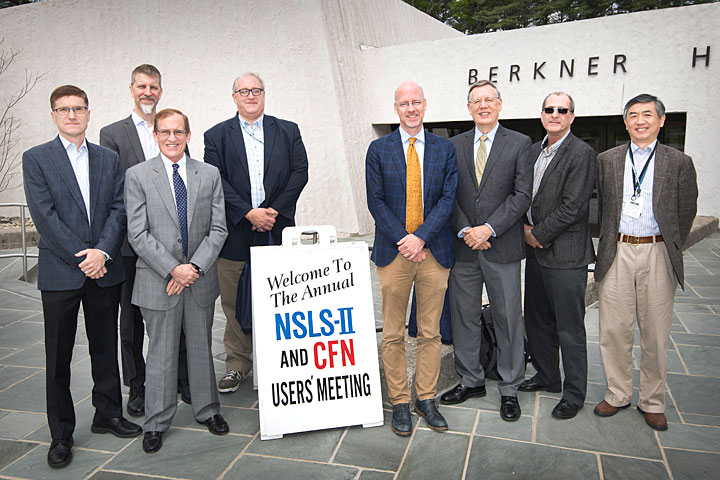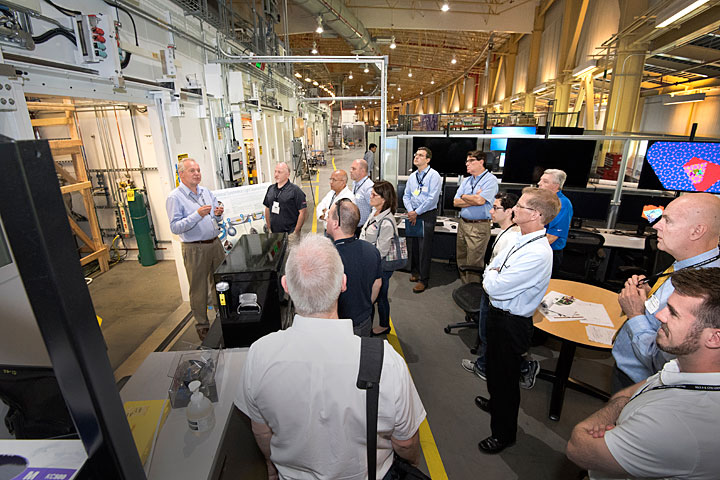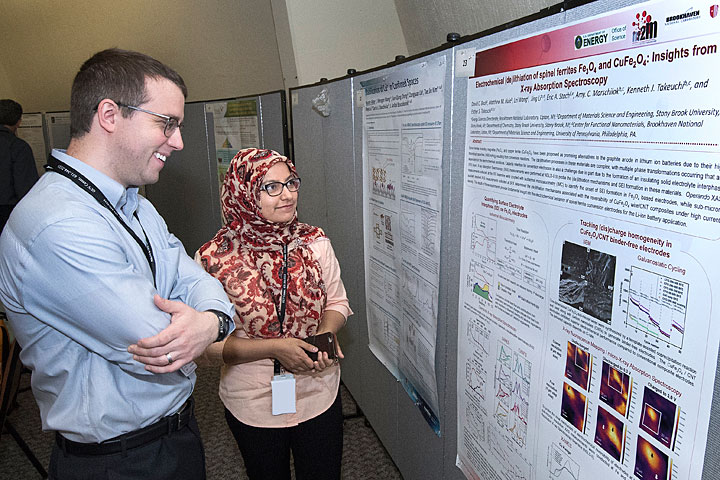In a New Light: 2018 NSLS-II and CFN Joint Users' Meeting
July 24, 2018
 enlarge
enlarge
Brookhaven, NSLS-II, and CFN management met with DOE representative Andrew Schwartz and former CFN Director Emilio Mendez. (From left to right: Andrew Schwartz, Chuck Black, Robert Tribble, Jim Misewich, John Hill, Emilio Mendez, Paul Zschack, and Qun Shen.)
This year’s Joint Users’ Meeting of the National Synchrotron Light Source II (NSLS-II) and the Center for Functional Nanomaterials (CFN)—two U.S. Department of Energy (DOE) Office of Science User Facilities located at DOE’s Brookhaven National Laboratory—presented itself in a new light with different format for the three-day conference.
The NSLS-II and CFN User Executive Committee (UEC) swapped out the old meeting style for a new and fresh take on the long agenda. This year, the meeting started on Monday with two day-long, hands-on workshops focused on education and computing, followed by the plenary sessions on Tuesday and Wednesday. The meeting included seven scientific workshops and offered scientists the chance to present their research to their peers. Additional to this well-filled agenda, the meeting offered many opportunities to network and discuss during coffee breaks, conference dinner, and the exhibitor fair and reception.
Robert Tribble, Brookhaven’s Deputy Director for Science, and Mark Dean, Vice Chair of the UEC and Leader of the inelastic x-ray scattering (RIXS) program in the Lab’s Condensed Matter Physics & Materials Science Division, officially welcomed the attendees to the meeting on Tuesday. The plenary session on Tuesday included presentations by the directors of CFN and NSLS-II and a representative of DOE’s Office of Science Basic Energy Science (BES).
On Wednesday, the scientific plenaries included three fascinating presentations from this year’s invited speakers. The first presentation was given by Andrea Alù, Temple Foundation Endowed professor at the University of Texas in Austin, who discussed how to tailor light with metamateriels and plasmonoics. Charles Ahn, Yale University’s William K. Lanman Jr. Professor of Applied Physics spoke about materials physics of complex oxide heterostructures. Umit Ozkan, Distinguished Professor at Ohio State University’s Chemical and Biomolecular Engineering department, presented new insights in x-ray absorption spectroscopy in heterogeneous catalysis and electro-catalysis studies.
DOE identifies quantum information science as a priority research area
During the plenary sessions, Andrew R. Schwartz, Senior Technical Advisor for DOE’s Energy Frontier Research Centers, discussed the role of user research facilities such as CFN and NSLS-II in the broader plan of the Department of Energy. Schwartz highlighted a letter issued by the Office of Science, which “identified quantum information science – not only just quantum computing – but the broader field of quantum information science as a priority research area for the whole Office of Science.” He pointed out that the role of BES is to support foundational research, which will advance the field of quantum information science in the next two decades through user research facilities.
 enlarge
enlarge
During the NSLS-II and CFN users' meeting, all attendees had the chance to tour both facilities and learn more about their capabilities.
“They will play a key role in advancing quantum information science,” Schwartz said, further elaborating on the existing funding initiatives for quantum information science research within BES. He said that there is a lot of interest and excitement about the opportunity, and that the foundational research funded through BES will enable advancements in this field for the next 10 to 15 years.
Schwartz’s presentation about the future of BES was followed by overviews of activities at NSLS-II and CFN during the past year and coming years. Both facility directors provided insights into what users can expect, and they conveyed their excitement at the continuing progress at NSLS-II and CFN.
Enabling excellent research capabilities for nanostructures
Chuck Black, Director of CFN, welcomed the attendees of this year’s meeting on behalf of CFN, and offered them a brief overview of his facility. He showed the history of user growth at CFN over the last 10 years and explained that CFN’s mission is to offer world-class research instrumentation and deliver impactful science to move the field of nanoscience forward.
“The combination of state-of-the-art instrumentation with a talented staff dedicated to supporting user science is essential to CFN’s success. Users value the experience of working with top caliber scientists and using world-class nanoscience equipment; our job is to help them achieve their goals. There are no other facilities like these in the world,” Black said.
Black also spoke about the diverse and impactful science that is carried out by CFN staff members including materials for capture of rare, radiological gases, DNA scaffolds for protein crystallization, and real-time electron tomography. In addition to their own research, CFN staff members assisted a wide variety of user research including colorful polymer solar cells, amorphous iron-based nano-coatings on steel and investigations of lithium-ion battery anodes. Black discussed that three strategic themes are based on CFN facility strengths and scientific accomplishments: self-assembled nanomaterials by design, the design and study of nano-architectures and the characterization of nanomaterials in operando. He highlighted that CFN’s new capabilities including nanoscale 3D printing and advanced x-ray scattering are well-aligned with these themes and that CFN will continue to deliver forefront, essential nanoscience capabilities to the worldwide research community and impactful science in the next years.
Science highlights and brilliant plans
Following Black’s presentation, John Hill, Director of NSLS-II, welcomed the attendees and presented last year’s statistics that demonstrated the reliability and success of NSLS-II as a user facility. Hill pointed out that the user program was growing rapidly together with the number of beamlines ready for general user proposals. NSLS-II will have 28 beamlines operating by the end of the year.
“It is an exciting time at NSLS-II and the Users’ meeting reflects that,” Hill said. “The machine is performing beautifully, the user program is ramping up quickly and the science is coming out. This last one is particularly exciting as experiments are being carried out at NSLS-II that could not be done anywhere else in the world. Our staff and users are using the ultra-high brightness of NSLS-II to study dynamic electronic processes, to solve structures of ever smaller crystals and to image chemical processes on the nanoscale, all for the first time. It is great to see everyone here, all sharing that excitement!”
 enlarge
enlarge
The poster sessions during the users' meeting offered scientists the opportunity to have lively discussions about their most recent work.
Hill also spoke about the upcoming cryo electron microscope facility, which will be funded by New York State and built at NSLS-II to complement the facility’s existing structural biology beamlines. In addition to all the exciting upgrades and new capabilities at NSLS-II, such as a world-leading nano-focus for imaging and the facility’s first nanotomographic measurements, Hill shed light upon NSLS-II user publications. He showed a number of examples, ranging from coherent scattering experiments on superconductors to x-ray imaging on arsenic in fern leafs. These and many more scientific experiments leverage the key strengths of NSLS-II: coherence, exceptional stability, high brightness, and multiscale imaging capabilities. Looking into the future, Hill spoke about maintaining operational excellence and improving the data acquisition, data analysis, and data management tools at the facility, as well as adding six new beamlines that were chosen through a rigorous, user-driven selection process, to complement the existing beamlines.
Workshop spotlights
All the Joint Users’ Meeting attendees had the opportunity to exchange insights about their specific research fields and discuss these new development among peers during nine workshop sessions.
On Monday, the “Bringing Big Science into the Classroom” workshop brought together NSLS-II and CFN scientists, educators, and school administrators to discuss how user facility tools can be used to promote authentic, student-driven research in the classroom. The participants learned how teachers and their students can become users of these facilities, allowing them to utilize unique research tools used by scientists from all over the world.
NSLS-II’s specialists offered a “Hands-On Data Acquisition and Analysis Tutorial” on how NSLS-II's data acquisition software, "Bluesky," and scientific Python enable sophisticated improvisation. The workshop offered explanations and lessons on data acquisition using Bluesky and data analysis using popular software from the scientific Python community.
In the “Emerging Nanomaterials and Nanostructures for Plasmonics and Nanophotonics Applications” workshop, world-renowned experts in nanomaetrials and nanostructures discussed the synthesis and characterization of emerging plasmonics and nanophotonics materials, as well as the study of light-matter interactions involving various types of nanostructures. The aim of this workshop was to provide a forum for the NSLS-II/CFN user community to explore the research frontier in plasmonics and nanophotonics, and to identify synergistic NSLS-II/CFN experiments, which can lead to transformative advances in the field.
The High-throughput and Data-driven Approaches Guiding Smart Operando Experiments workshop brought together experts in synergetic areas of high-throughput experimental and computational methodologies and data analytics to document state-of-the-art developments in the field. It emphasized examples of successful implementation of high-throughput experiment-theory-data synergy, as well as devising strategies to tackle emerging roadblocks.
The Soils for a Sustainable Future workshop was focused on the experimental platforms available at the National User Facilities NSLS-II and the Environmental Molecular Sciences Laboratory (EMSL), located at the Pacific Northwest National Laboratory (PNNL), which can each provide molecular insights to the biogeochemical and microbial processes. The attendees explored how both facilities, through the use of joint capabilities, can help generate the knowledge that leads to improved processes for sustainable agriculture and biocrop production, and to a capacity increase in soils as a long-term carbon reservoir.
The objective of the Characterization of Electrochemical Energy Storage Systems: Advanced Spectroscopy, Microscopy and Diffraction Techniques workshop was to showcase state-of-the art capabilities in spectroscopy, diffraction, and microscopy techniques as they apply to electrochemical energy storage systems. The researchers discussed topics such as x-ray and neutron diffraction for determining phase transition behaviors of electrode materials during cycling, the development of new x-ray fluorescence and transmission x-ray microscopy techniques for imaging materials, and the use of operando x-ray absorption spectroscopy for determining evolution of oxidation state and local structure.
Inhomogeneities are a widespread feature of many of the most interesting quantum materials, either due to intrinsic phase separation or deliberate fabrication of artificial heterostructures. Existing and planned beamlines at NSLS-II are designed to focus on these problems exploiting NSLS-II’s cutting edge brightness and coherence. Experts from the field of quantum materials science discussed these exciting possibilities in the Nanoscale Phenomena in Quantum Materials workshop.
The One-stop BNL Characterization Toolbox for the Rational Design of Clean Fuel Catalysts workshop showcased state-of-the-art industrial and research catalyst developments, identifying key scientific questions and experimental conditions that are essential to study working catalysts, and enabling instrument access modes. A second session, focused on successful operando synchrotron experiments, showed not only the status of the existing technology and data analysis but also laid the base for a gap analysis to identify action items to fully utilize the state-of-the-art instruments and data analysis approaches at Brookhaven.
The Synchrotron Infrared Spectroscopy on Materials in Extreme Environments workshop brought together synchrotron-IR users to discuss the applications of the high-pressure IR spectroscopy in geoscience and planetary science as well as condensed matter physics and materials science. These spectroscopic techniques for materials in extreme conditions exploit the unique instrumentation at NSLS-II, all of which will be available to the user community. The researchers discussed opportunities for dynamic compression (transient high-P) studies, and the potential role of combined pressure and magnetic field to explore novel electronic properties and emergence.
All workshop were well attended and offered many opportunities for exchange and discussions between this year’s attendees. Feedback from workshop participants indicated they enjoyed the stimulating and engaging discussion across various fields of research and used this opportunity to exchange ideas, knowledge, and experience. NSLS-II and CFN look forward to hosting their next joint Users’ Meeting in 2019.
Brookhaven National Laboratory is supported by the Office of Science of the U.S. Department of Energy. The Office of Science is the single largest supporter of basic research in the physical sciences in the United States, and is working to address some of the most pressing challenges of our time. For more information, please visit science.energy.gov.
Follow @BrookhavenLab on Twitter or find us on Facebook.
2018-13009 | INT/EXT | Newsroom









